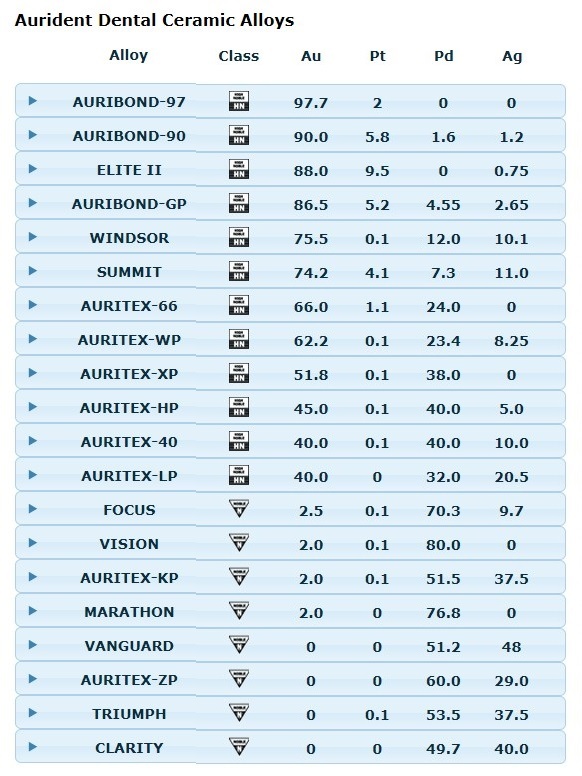Dr. Hall,
Recently from my periodontist who also does cosmetic dentistry I was fitted with 6 high noble porcelain-fused-to-metal crowns. I knew they were PFM crowns but later I discovered they are Encore crowns and contain 40% palladium. I have read of the toxicity of this metal and am concerned that there is such a high percentage of it in my crowns. I am now considering having them removed and considering e.max or even zirconia, whichever is the most inert. I hope you will advise me on what steps I should take.
Thank you for your time.
– Sandra from Delaware
We thank our advertisers who help fund this site.
Sandra,
I was struck by your question because I had never heard of palladium toxicity, and I try to keep myself informed of these things. Many dentists, I feel, are much too casual about metal toxicity issues. You can check other posts in this blog where I list various metals used by some dentists that cause sensitivity reactions. But palladium? I decided to do some research to see where this idea comes from.
In the movie Iron Man 2, Tony Stark has an arc reactor that keeps him alive and powers his armor, and this arc reactor has a palladium core. In the movie, the palladium is poisoning his blood. In the real world, however, palladium is a noble metal and a member of the platinum group, and is fairly biocompatible. Yes, there are compounds such as palladium chloride that are toxic, but that is very different from the pure metal. And remember, that we are not talking about putting this metal into the tissue but only putting it into a situation where you are in superficial contact with it.
Also, in doing an online search, I discovered a natural health website that alleged that palladium is a heavy metal that is highly toxic. (not true—palladium is a precious metal that is actually fairly light.) To put their claims in context, near the bottom of the page is a link for visitors to get themselves tested to see if they have palladium toxicity. The link takes us to a page that urges visitors to send in $325 for a hair mineral analysis. So if we follow the money it seems that we are discovering the motivation for their mis-information.
Almost every dental alloy that is used in making crowns and bridges has palladium in it. Like platinum and gold, palladium doesn’t corrode. Its presence in a dental alloy lends a certain amount of stiffness to the alloy, so it is pretty much required in stress-bearing dental bridges. Alloys without palladium tend to be very soft.
Here is a chart of dental alloys manufactured by Aurident for use with porcelain-fused-to-metal crowns. Aurident is one of the leading manufacturers of dental alloys.

You can see the percentage composition of the various alloys. Au is gold, Pt is platinum, Pd is palladium, and Ag is silver. Notice that palladium, while it isn’t in every alloy, it is a component of more alloys than any other metal. When it isn’t present, the metal will be softer and will be more yellow in color. Soft is good in some situations. It makes the metal easy to burnish so that it fits tightly to the tooth. But a soft metal without palladium can also make the restoration susceptible to bending or breaking. The second column, labeled “class,” shows how the alloy is categorized. The square icon with the HN means high noble. These are alloys that have at least 40% gold and a total of at least 60% noble (precious) metals, of which palladium is one. Sometimes these alloys are simply called “gold,” and the term “porcelain fused to gold” is used. The triangles with the N are noble alloys that have at least 25% precious metals.
Even with gold alloys used in gold crowns, almost all of them have palladium in the alloy.
In my mouth, four of my crowns have metal in them—three gold and one porcelain-fused-to-metal—and I am pretty confident that each of them has some palladium content.
My opinion, Sandra—you don’t have anything to worry about, and as long as you are happy with how they look and aren’t having an allergic reaction, I would leave well enough alone. There are some instances reported of palladium allergy. If that is your situation, you will have symptoms such as redness in the gums around the crowns and/or an itching or burning sensation there.
Switching to zirconia? While rare, there are also some instances that have been reported of zirconia allergy. I had one woman write to me who, after going the rounds with several dentists, finally decided that she was allergic to the zirconia in her crowns. I have decided never to tell someone that it’s impossible for them to be allergic to some dental material. Sometimes it seems that putting anything artificial in your mouth carries at least a tiny amount of risk. Wouldn’t that be ironic if you are having no reaction to the palladium and switch to something else only to find out that you are actually allergic to the new material!
– Dr. Hall
Do you have a comment or anything else to add? We’d love to hear from you. Enter your comment below.
Click here to ask Dr. Hall a question of your own.
About David A. Hall
Dr. David A. Hall was one of the first 40 accredited cosmetic dentists in the world. He practiced cosmetic dentistry in Iowa, and in 1990 earned his accreditation with the American Academy of Cosmetic Dentistry. He is now president of Infinity Dental Web, a company in Mesa, Arizona that does advanced internet marketing for dentists.
